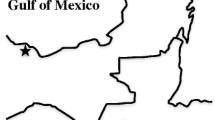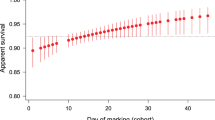Abstract
Body size is often related to reproductive success in insects, but the direction and strength of this relationship differs greatly among systems. We studied the effects of adult size on probability of mating and egg production in the Miami blue butterfly. We found that likelihood of mating was invariant with respect to size. Larger females lived longer, and both size and lifespan positively influenced egg production. However, neither the number of copulations nor the size of male mates had any effect on female fecundity. We discuss these results in the context of butterfly mating systems, larval growth strategies and the possible effects of captive conditions on reproductive behavior.

Similar content being viewed by others
References
Bauerfeind SS, Fischer K (2008) Maternal body size as a morphological constraint on egg size and fecundity in butterflies. Basic Appl Ecol 9:443–451
Bel-Venner MC, Dray S, Allaine D, Menu F, Venner S (2008) Unexpected male choosiness for mates in a spider. Proc R Soc Lond B Biol Sci 275:77–82
Berger D, Walters R, Gotthard K (2006) What keeps insects small? Size dependent predation on two species of butterfly larvae. Evol Ecol 20:575–589
Berger D, Walters R, Gotthard K (2008) What limits insect fecundity? Body size- and temperature-dependent egg maturation and oviposition in a butterfly. Funct Ecol 22:523–529
Bergman M, Gotthard K, Berger D, Olofsson M, Kemp DJ, Wiklund C (2007) Mating success of resident versus non-resident males in a territorial butterfly. Proc R Soc Lond B Biol Sci 274:1659–1665
Bernays EA (1997) Feeding by lepidopteran larvae is dangerous. Ecol Entomol 22:121–123
Blanckenhorn WU (2000) The evolution of body size: what keeps organisms small? Q Rev Biol 75:385–407
Bollache L, Cezilly F (2004) Sexual selection on male body size and assortative pairing in Gammarus pulex (Crustacea: Amphipoda): field surveys and laboratory experiments. J Zool 264:135–141
Brown WD (1990) Size-assortative mating in the blister beetle Lytta magister (Coleoptera, Meloidae) is due to male and female preference for larger mates. Anim Behav 40:901–909
Bryant EH, Reed DH (1999) Fitness decline under relaxed selection in captive populations. Conserv Biol 13:665–669
Elgar MA, Pierce NE (1988) Mating success and fecundity in an ant-tended lycaenid butterfly. In: Clutton-Brock TH (ed) Reproductive success: studies of selection and adaptation in contrasting breeding systems. University of Chicago Press, Chicago, pp 59–75
Ellers J, Sevenster JG, Driessen G (2000) Egg load evolution in parasitoids. Am Nat 156:650–665
Fischer K, Fiedler K (2000) Sex-related differences in reaction norms in the butterfly Lycaena tityrus (Lepidoptera: Lycaenidae). Oikos 90:372–380
Fleming IA, Jonsson B, Gross MR, Lamberg A (1996) An experimental study of the reproductive behaviour and success of farmed and wild Atlantic salmon (Salmo salar). J Appl Ecol 33:893–905
Florida Fish and Wildlife Conservation Commission (2003). Management plan: Miami blue Cyclargus (=Hemiargus) thomasi bethunebakeri. State of Florida, Tallahassee, Florida, USA
Gotthard K (2000) Increased risk of predation as a cost of high growth rate: an experimental test in a butterfly. J Anim Ecol 69:896–902
Gotthard K (2004) Growth strategies and optimal body size in temperate Pararginii butterflies. Integr Comp Biol 44:471–479
Gotthard K (2008) Adaptive growth decisions in butterflies. Bioscience 58:222–230
Gotthard K, Nylin S, Wiklund C (2000) Mating opportunity and the evolution of sex-specific mortality rates in a butterfly. Oecologia 122:36–43
Gotthard K, Berger D, Walters R (2007) What keeps insects small? Time limitation during oviposition reduces the fecundity benefit of female size in a butterfly. Am Nat 169:768–779
Harari AR, Handler AM, Landolt PJ (1999) Size-assortative mating, male choice and female choice in the curculionid beetle Diaprepes abbreviatus. Anim Behav 58:1191–1200
Honek A (1993) Intraspecific variation in body size and fecundity in insects—a general relationship. Oikos 66:483–492
Iyengar VK, Eisner T (2004) Male indifference to female traits in an arctiid moth (Utetheisa ornatrix). Ecol Entomol 29:281–284
Kemp DJ (2008) Female mating biases for bright ultraviolet iridescence in the butterfly Eurema hecabe (Pieridae). Behav Ecol 19:1–8
Klingenberg CP, Spence JR (1997) On the role of body size for life-history evolution. Ecol Entomol 22:55–68
Langellotto GA, Denno RF, Ott JR (2000) A trade-off between flight capability and reproduction in males of a wing-dimorphic insect. Ecology 81:865–875
Leather SR (1988) Size, reproductive potential and fecundity in insects—things aren’t as simple as they seem. Oikos 51:386–389
Lomnicki A, Jasienski M (2000) Does fitness erode in the absence of selection? An experimental test with Tribolium. J Hered 91:407–411
Pureswaran DS, Borden JH (2003) Is bigger better? Size and pheromone production in the mountain pine beetle, Dendroctonus ponderosae Hopkins (Coleoptera: Scolytidae). J Insect Behav 16:765–782
Saarinen EV, Daniels JC (2006) Miami blue butterfly larvae (Lepidoptera: Lycaenidae) and ants (Hymeoptera: Formicidae): new information on the symbionts of an endangered taxon. Fla Entomol 89:69–74
Sutherland DL, Hogg ID, Waas JR (2007) Is size assortative mating in Paracalliope fluviatilis (Crustacea: Amphipoda) explained by male-male competition or female choice? Biol J Linn Soc 92:173–181
Tammaru T, Esperk T, Castellanos I (2002) No evidence for costs of being large in females of Orgyia spp. (Lepidoptera, Lymantriidae): larger is always better. Oecologia 133:430–438
Trager MD, Daniels JC (2009) Ant tending of Miami blue butterfly larvae (Lepidoptera: Lycaenidae): partner diversity and effects on larval performance. Fla Entomol 92:474–482
Visser ME (1994) The importance of being large—the relationship between size and fitness in females of the parasitoid Aphaereta minuta (Hymenoptera, Braconidae). J Anim Ecol 63:963–978
Acknowledgments
We thank Bret Boyd and Matt Standridge for assistance with maintaining the captive colony and performing the experiments. We thanks the Florida Fish and Wildlife Conservation Commission, E.O. Dunn Foundation, U.S. Fish and Wildlife Service and the National Fish and Wildlife Foundation for funding; additionally, M.D. Trager was funded by a National Science Foundation Graduate Research Fellowship. Research for this study was conducted under Florida Fish and Wildlife Conservation Commission permit WX02525f. We thank two anonymous reviewers for helpful comments on a previous version of this paper.
Author information
Authors and Affiliations
Corresponding author
Rights and permissions
About this article
Cite this article
Trager, M.D., Daniels, J.C. Size Effects on Mating and Egg Production in the Miami Blue Butterfly. J Insect Behav 24, 34–43 (2011). https://doi.org/10.1007/s10905-010-9234-8
Revised:
Accepted:
Published:
Issue Date:
DOI: https://doi.org/10.1007/s10905-010-9234-8




